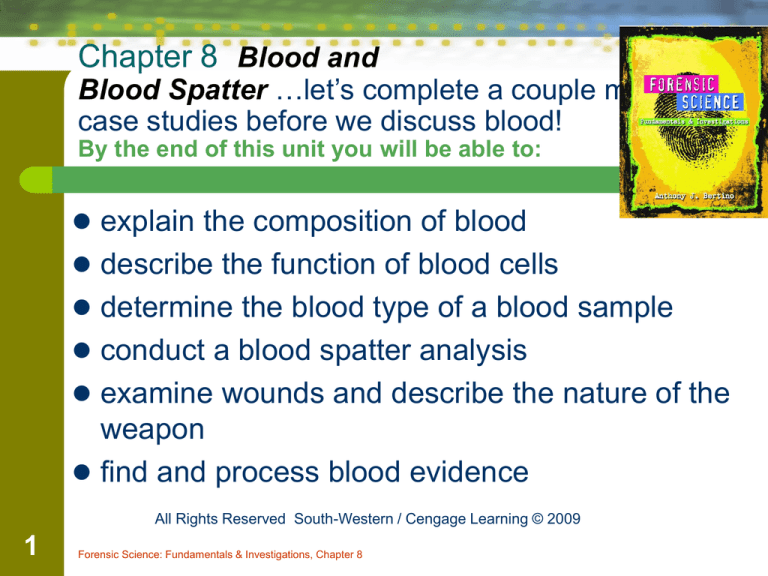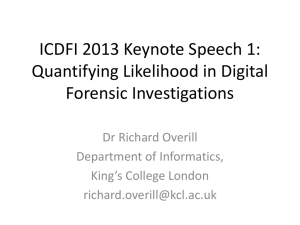
Chapter 8 Blood and
Blood Spatter …let’s complete a couple more
case studies before we discuss blood!
By the end of this unit you will be able to:
explain the composition of blood
describe the function of blood cells
determine the blood type of a blood sample
conduct a blood spatter analysis
examine wounds and describe the nature of the
weapon
find and process blood evidence
All Rights Reserved South-Western / Cengage Learning © 2009
1
Forensic Science: Fundamentals & Investigations, Chapter 8
Introduction and History
2
Blood typing can provide class evidence;
whereas DNA profiling can provide individual
evidence.
A blood spatter pattern can give information
about the truthfulness of an account by a
witness or a suspect.
It also can provide information about the origin of
the blood, the angle and velocity of impact, and
type of weapon used.
Our understanding of blood began in ancient
times and continues to grow today.
Forensic Science: Fundamentals & Investigations, Chapter 8
This is Dr. Henry Lee,
the world’s leading
serologist specialist.
He has been involved
with over six
thousand cases within
the past forty years.
Serologists are people who study
blood in a forensics laboratory.
3
Forensic Science: Fundamentals & Investigations, Chapter 8
Blood Detection…see
activity 8.1
Phenolphthalein
Luminol
4
Forensic Science: Fundamentals & Investigations, Chapter 8
Transferred blood
Footprint
5
Forensic Science: Fundamentals & Investigations, Chapter 8
Handprint
Luminol is a chemical that
reacts with the hemoglobin
in the blood to produce a
blue luminescence.
Luminol is used by
investigators when the
blood is wiped away and
is therefore no longer
visible to the naked eye.
The brighter and stronger the glow, the
more recent (and fresh) the blood is.
The brighter and stronger the glow,
the more heavy the blood flow.
6
Forensic Science: Fundamentals & Investigations, Chapter 8
7
Forensic Science: Fundamentals & Investigations, Chapter 8
8
Forensic Science: Fundamentals & Investigations, Chapter 8
Composition of Blood
Whole blood carries cells and plasma—the fluid
9
with hormones, clotting factors, and nutrients.
Shown above respectively:
Red blood cells carry oxygen to the body’s cells
and carbon dioxide away.
White blood cells fight disease and foreign
invaders and, alone, contain cell nuclei.
Platelets aid in blood clotting and the repair of
damaged blood vessels.
Forensic Science: Fundamentals & Investigations, Chapter 8
Blood Typing—Proteins
42%
12%
3%
of the population in the United States
(of which 85% is Rh+)
43%
Blood typing is quicker and less expensive than
DNA profiling.
It produces class evidence but can still link a
suspect to a crime scene or exclude a suspect.
10
Forensic Science: Fundamentals & Investigations, Chapter 8
Blood Typing—Antibodies; Additional
Proteins and Enzymes
Antibodies are proteins secreted by white
blood cells that attach to antigens to destroy
them.
Antigens are foreign molecules or cells that
react to antibodies.
Enzymes are complex proteins that catalyze
different biochemical reactions.
Many enzymes and proteins have been found in
the blood that are important for identification
purposes.
11
Forensic Science: Fundamentals & Investigations, Chapter 8
Blood Typing—Probability and
Blood Types
Given the frequency of different genes within a
population, it is possible to determine the
probability that a particular blood type will appear
in a particular population.
To determine the probability of two separate
events, it is necessary to multiply their individual
probabilities.
By identifying the additional proteins in the blood
evidence sample, investigators can limit the size of
a suspect population and help identify a suspect.
12
Forensic Science: Fundamentals & Investigations, Chapter 8
Blood Spatter
13
In 1939 the meaning of the spatter pattern was
first analyzed.
When a wound is inflicted, a blood spatter
pattern may be created.
It takes a grouping of blood stains to make a
blood spatter pattern.
The pattern can help to reconstruct the events
surrounding a shooting, stabbing, or beating.
Forensic Science: Fundamentals & Investigations, Chapter 8
Why study Blood Spatter?
◊ To find out where an assault occurred
◊ To find out the position of the killer during the attack
◊ To find out if the victim was walking or running
during the attack
◊ To find out if victims tried to avoid the blows, by
holding up object or arms to avoid the hits.
(There would be a gap in the spatter if this happened.)
◊ To find out the type of blood for victim or suspect
identification
14
◊ To find out how long the blood has been there to
find a time frame for the attacks
Forensic Science: Fundamentals & Investigations, Chapter 8
Blood Splatter Analysis
Analysis of a spatter pattern can aid in
determining the:
– direction blood traveled.
– angle of impact.
– point of origin of the blood.
– velocity of the blood.
– manner of death.
15
Forensic Science: Fundamentals & Investigations, Chapter 8
Simpson Crime Scene
16
Forensic Science: Fundamentals & Investigations, Chapter 8
17
Forensic Science: Fundamentals & Investigations, Chapter 8
18
Forensic Science: Fundamentals & Investigations, Chapter 8
Does blood spatter evidence
consistent with the story told by
witness or suspect?
19
Forensic Science: Fundamentals & Investigations, Chapter 8
Blood Spatter
Analysis
When blood falls from a height or at a high
velocity, it can overcome its natural
cohesiveness and form satellite droplets.
When it falls onto a less-than-smooth
surface, it can form spiking patterns around
the drops.
20
Forensic Science: Fundamentals & Investigations, Chapter 8
Blood Spatter Analysis—Six
Patterns
Describe each of these:
a. passive drops
b. arterial gushes
c. splashes
d. smears
e. trails
f. pools
21
Forensic Science: Fundamentals & Investigations, Chapter 8
Arterial Gush
22
Forensic Science: Fundamentals & Investigations, Chapter 8
Arterial Spurting (or
Gushing) Pattern Bloodstain pattern that
results from blood exiting
the body under pressure
from a breached artery. The
blood gushes out with the
rhythm of the heart.
Cast off pattern- Created when
blood is released or thrown from
a blood bearing object in motion
(for example a knife). These are
also called cast-off stains.
23
Forensic Science: Fundamentals & Investigations, Chapter 8
Drip Pattern- A blood
stain pattern which
results from dripped
blood either from a
weapon, victim or
sometimes the killer.
Flow pattern- A
blood stain pattern
which shows a
change in shape
and direction due to
gravity or other
forces.
24
Forensic Science: Fundamentals & Investigations, Chapter 8
Swipe pattern- this
pattern is created when
blood is transferred from
a moving source onto
an unstained surface.
Contact PatternsThese types of
patterns occur
when a wet or
bloody surface
comes into
contact with a
second surface.
25
Forensic Science: Fundamentals & Investigations, Chapter 8
This type of stain can tell
how many times a person
was hit. The number of
stains is always one less
than the number of hits,
because the first time the
weapon hits there is no
blood on it.
26
Forensic Science: Fundamentals & Investigations, Chapter 8
Types of Injury
27
High velocity
(gunshot)
Medium velocity
(hammer strike)
Low velocity ( drip)
Forensic Science: Fundamentals & Investigations, Chapter 8
Hammer strike-low velocity
28
Forensic Science: Fundamentals & Investigations, Chapter 8
Blood Spatter Analysis—Impact
Patterns can help investigators determine the
type of weapon used.
29
–
What kind of a pattern is produced by a gun
shot?
–
What kind of a pattern is produced by a
hammer blow?
Forensic Science: Fundamentals & Investigations, Chapter 8
Surfaces
If the surface is more
rough and porous, the
spatter will be absorbed.
This picture shows the
blood spatter on a carpet.
If the surface is hard,
smooth and flat, like tile,
the spatter will break up
into lots of little drops, and
they will be round. This
picture shows a close up
30 of one of the drops.
Forensic Science: Fundamentals & Investigations, Chapter 8
31
The greater the height,
the greater the amount
of spatter.
Forensic Science: Fundamentals & Investigations, Chapter 8
A blood drop falling
perpendicular onto a surface (at
a 90º angle) will leave a round
blood stain where it drops.
A blood drop falling at
an angle other than 90º
will leave an elongated
stain.
The steeper the angle, the more elongated the blood stain.
32
Forensic Science: Fundamentals & Investigations, Chapter 8
Blood Spatter Analysis—
Directionality
The shape of an individual drop of blood
provides clues to the direction from where
the blood originated.
How will the point of impact compare
with the rest of a blood pattern?
33
Forensic Science: Fundamentals & Investigations, Chapter 8
The tail of the spatter tells us the direction
the blood spatter came from.
34
Forensic Science: Fundamentals & Investigations, Chapter 8
Blood Spatter
Analysis—Location of the Origin of the
Blood
35
Lines of convergence
Draw straight lines down the axis of the
blood splatters.
Where the lines converge, the blood
originated.
Forensic Science: Fundamentals & Investigations, Chapter 8
36
Forensic Science: Fundamentals & Investigations, Chapter 8
Points of Convergence
37
The red circle shoes the point of convergence.
Forensic Science: Fundamentals & Investigations, Chapter 8
38
Forensic Science: Fundamentals & Investigations, Chapter 8
Crime scene
39
Forensic Science: Fundamentals & Investigations, Chapter 8
Crime scene
40
Forensic Science: Fundamentals & Investigations, Chapter 8
Reconstruction of crime scene
41
Forensic Science: Fundamentals & Investigations, Chapter 8
One of Bundy’s victims
42
Forensic Science: Fundamentals & Investigations, Chapter 8
Sharon Tate crime scene
43
Forensic Science: Fundamentals & Investigations, Chapter 8
Ron Goldman
44
Forensic Science: Fundamentals & Investigations, Chapter 8
Crime Scene Investigation
of Blood
Search for blood evidence.
2. If any is discovered, process it determining:
a. Whether the evidence is blood.
b. Whether the blood is human.
c. The blood type.
3. Interpret the findings:
a. See if the blood type matches a suspect.
b. If it does not, exclude that suspect.
c. If it does, decide if DNA profiling is needed.
1.
45
Forensic Science: Fundamentals & Investigations, Chapter 8
. . . . . . . . . . . . . . . . . Summary
Blood consists of cellular components and plasma.
The various human blood types are caused by the
presence or absence of A or B or both A and B
proteins on the surface of red blood cells.
Blood spatter evidence can be used to recreate a
crime scene.
Investigators endeavor to (a) locate, (b) identify,
and (c) interpret blood splatter patterns at crime
scenes.
Blood patterns will help determine the weapon,
direction and location of impact.
46
Forensic Science: Fundamentals & Investigations, Chapter 8





